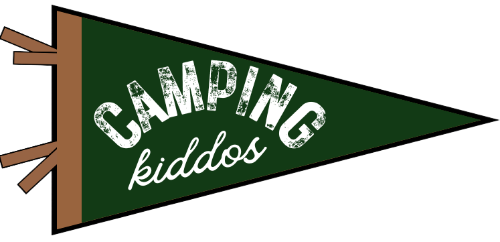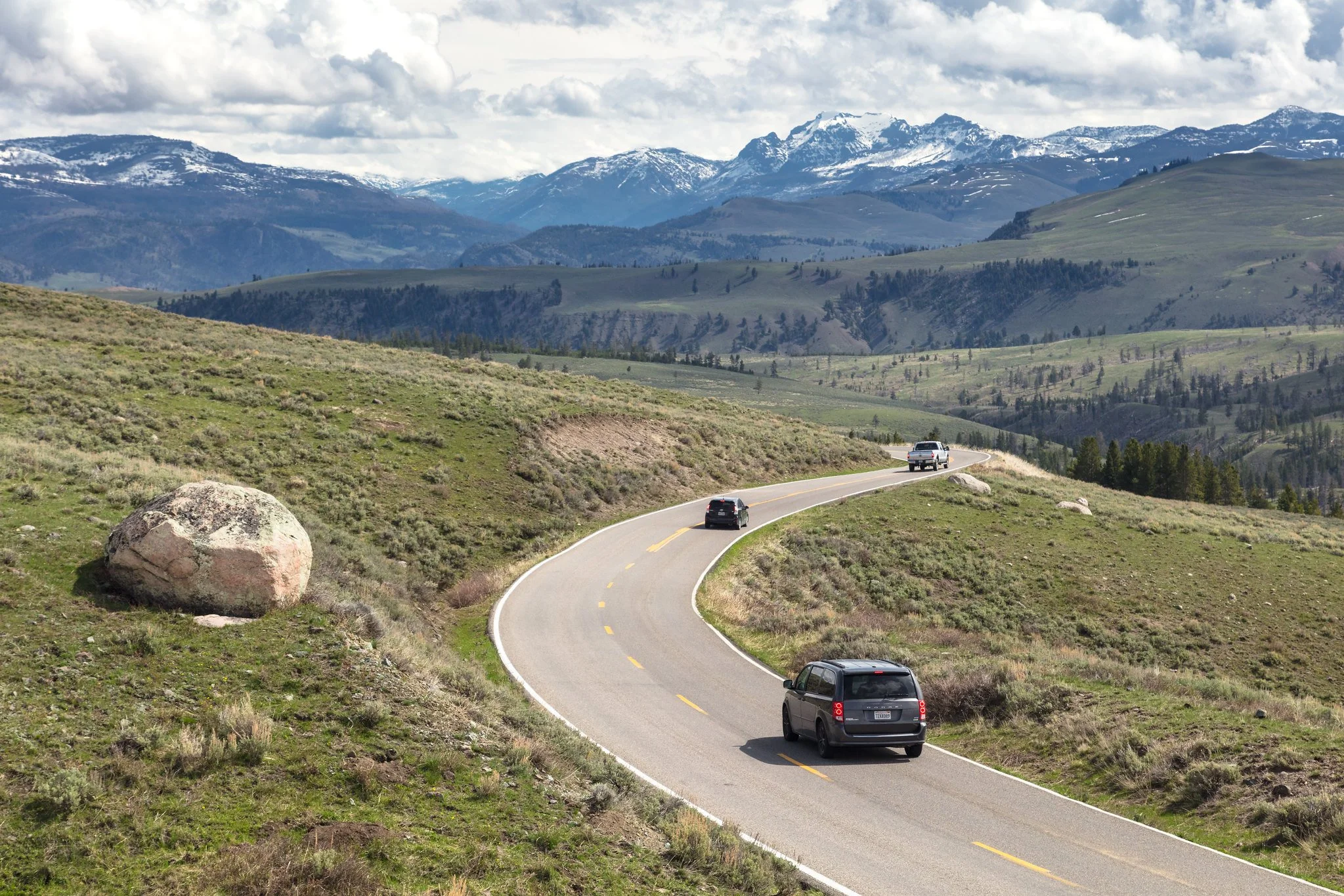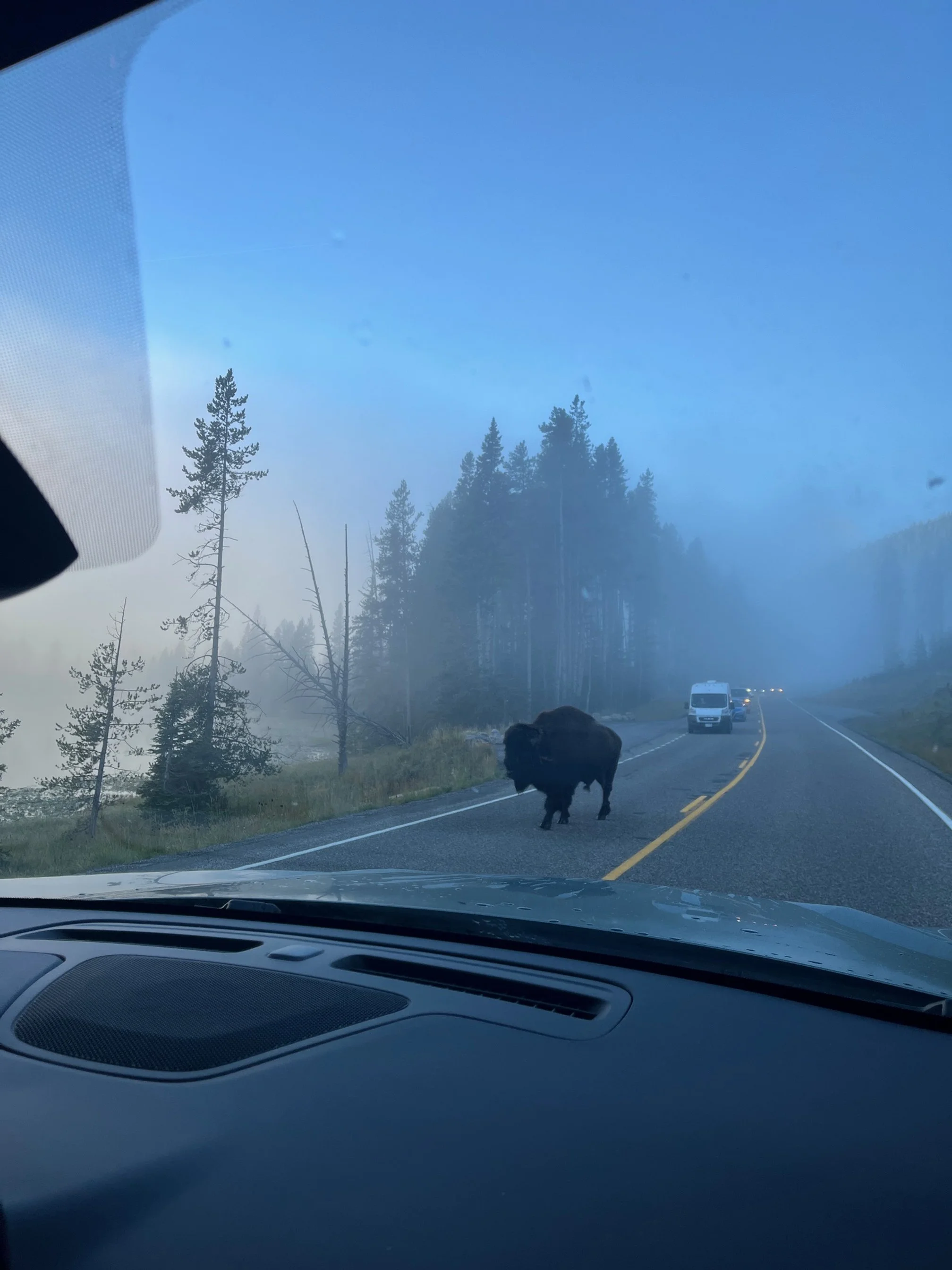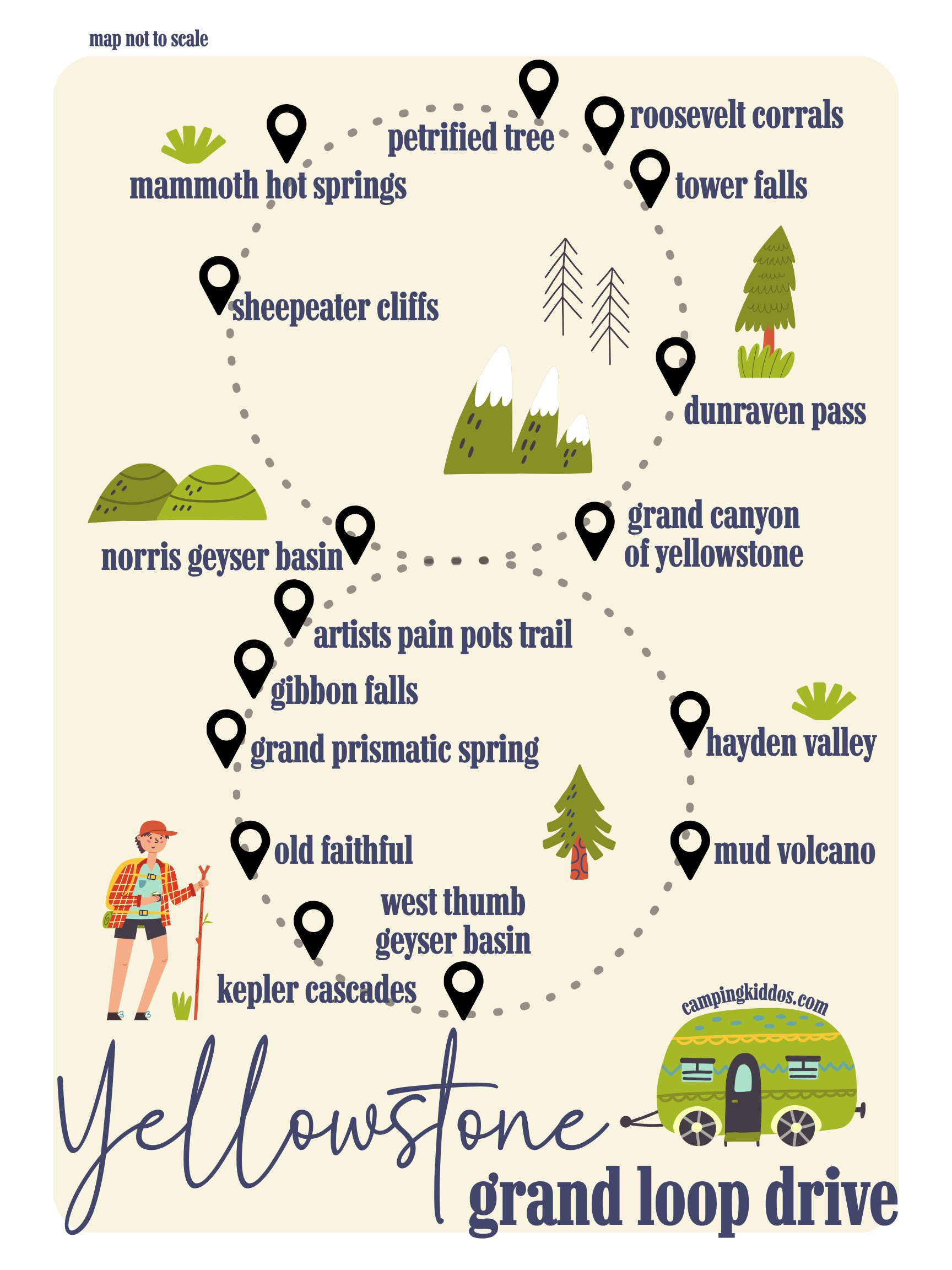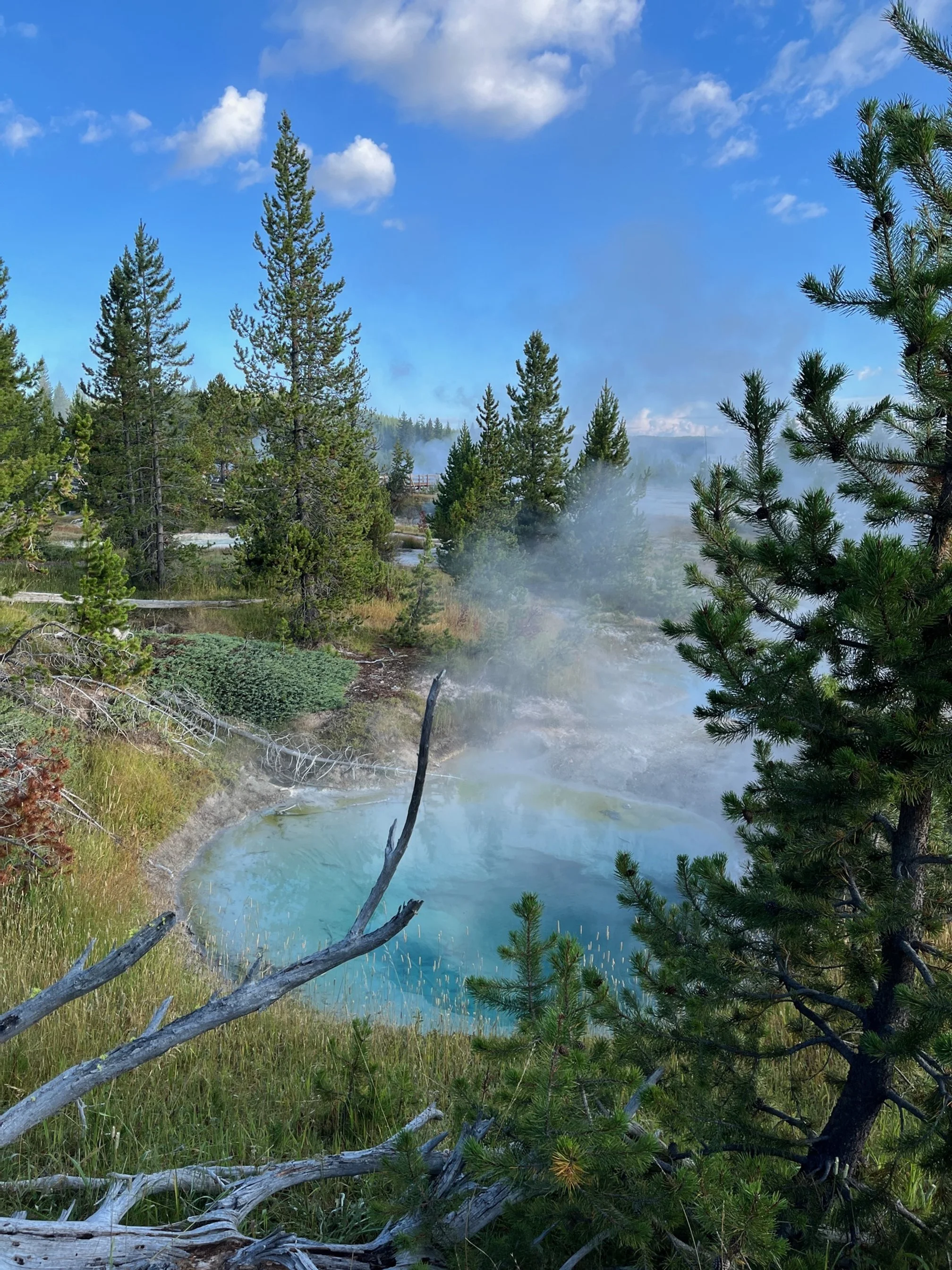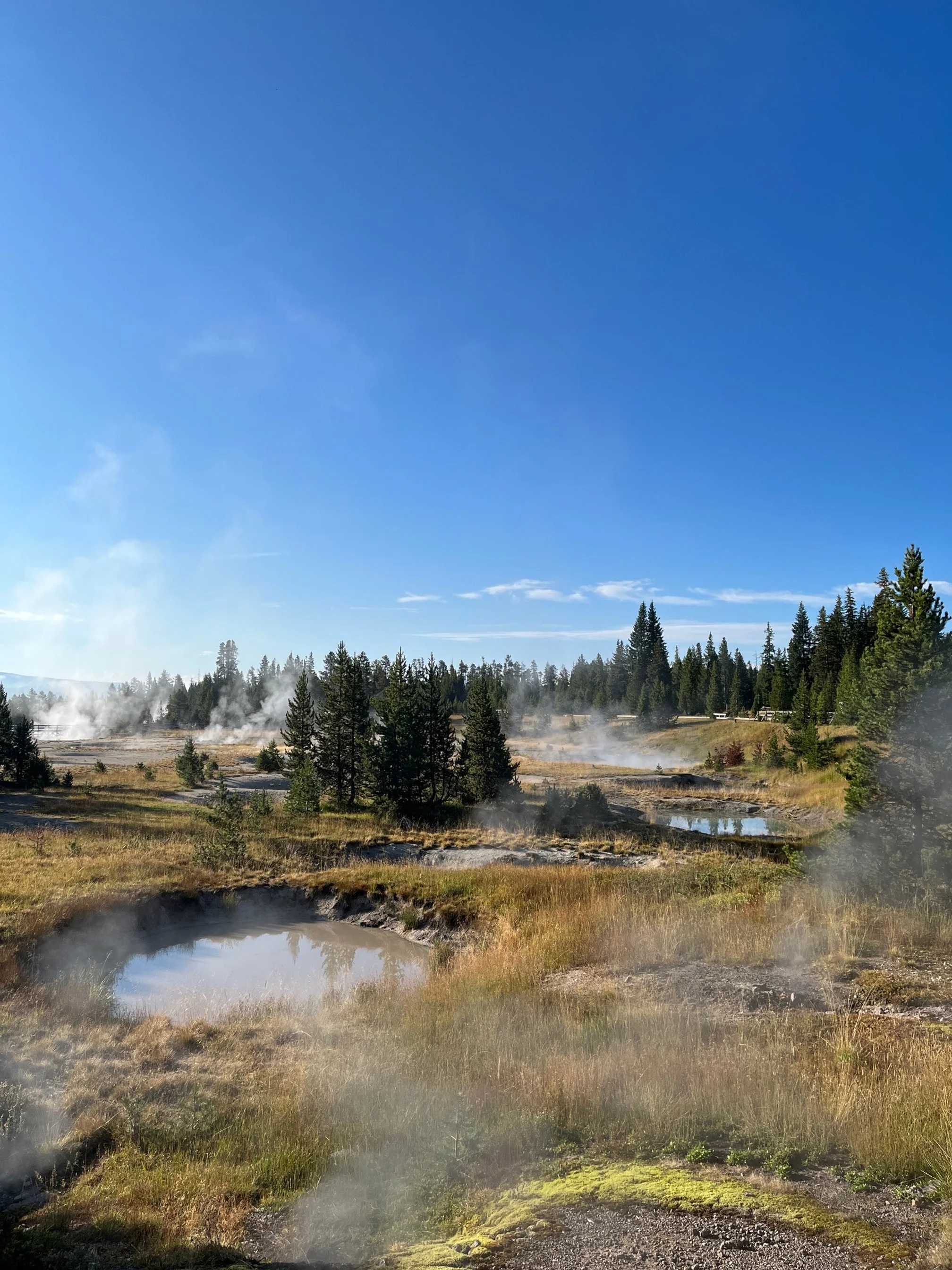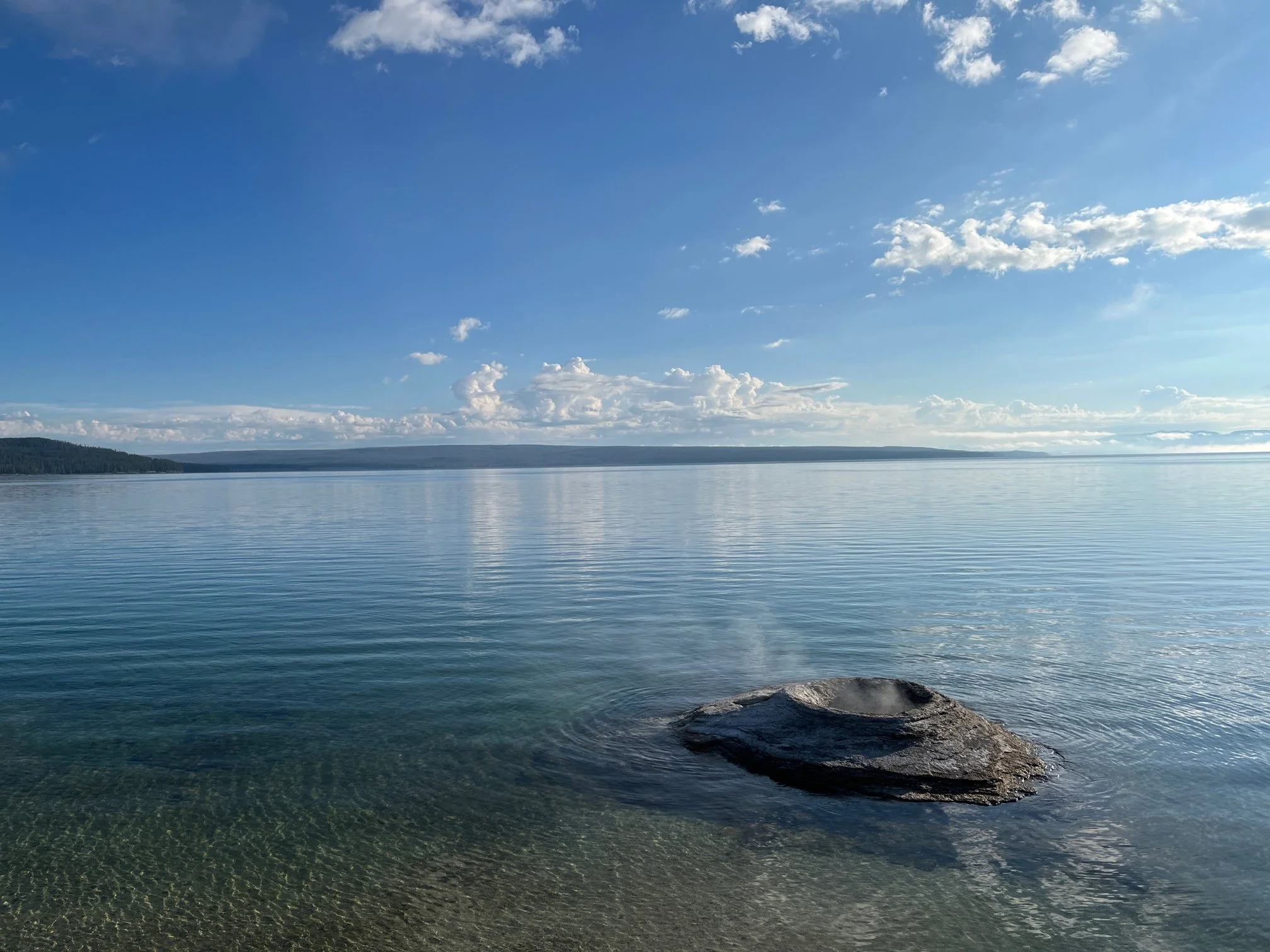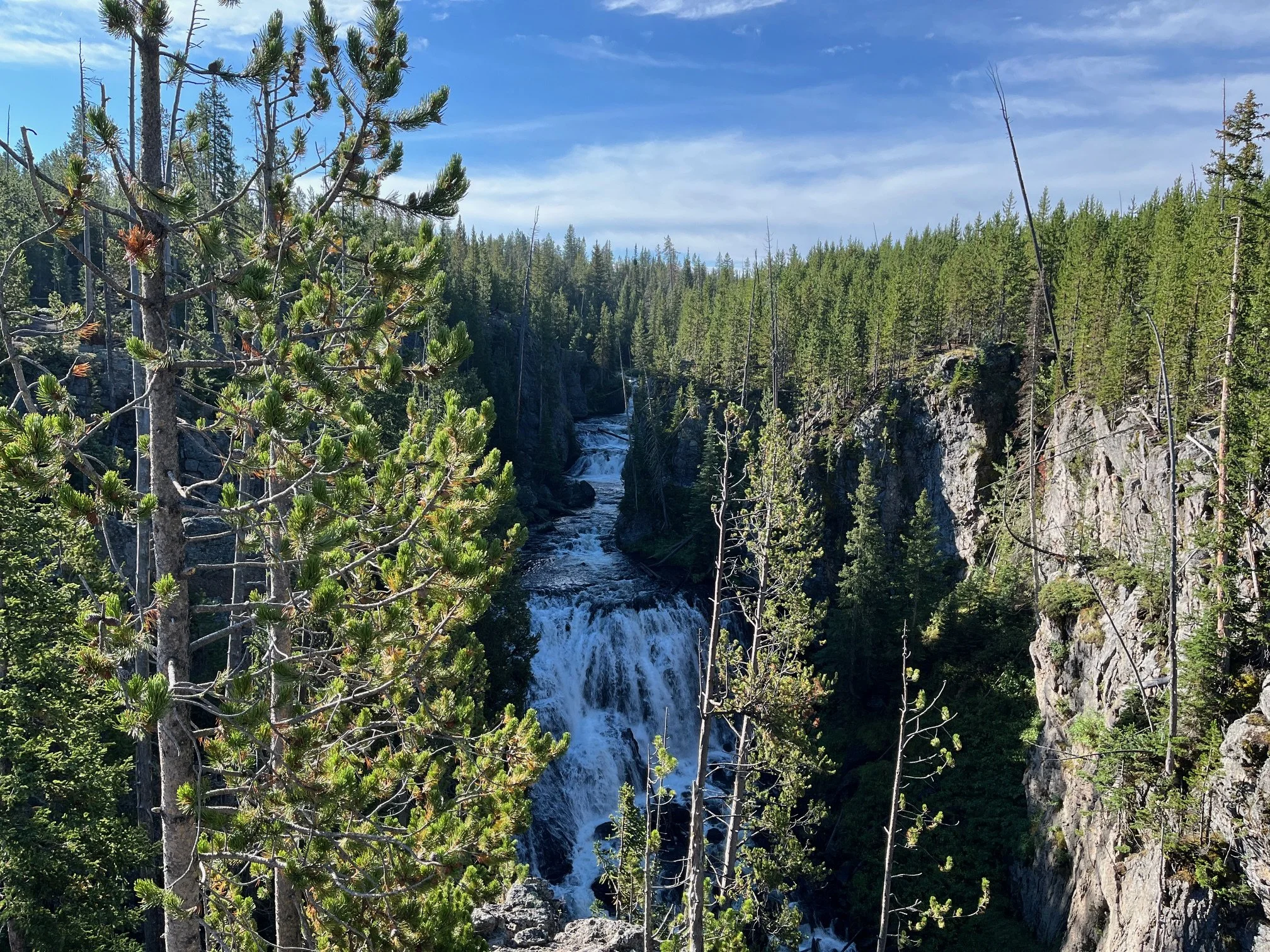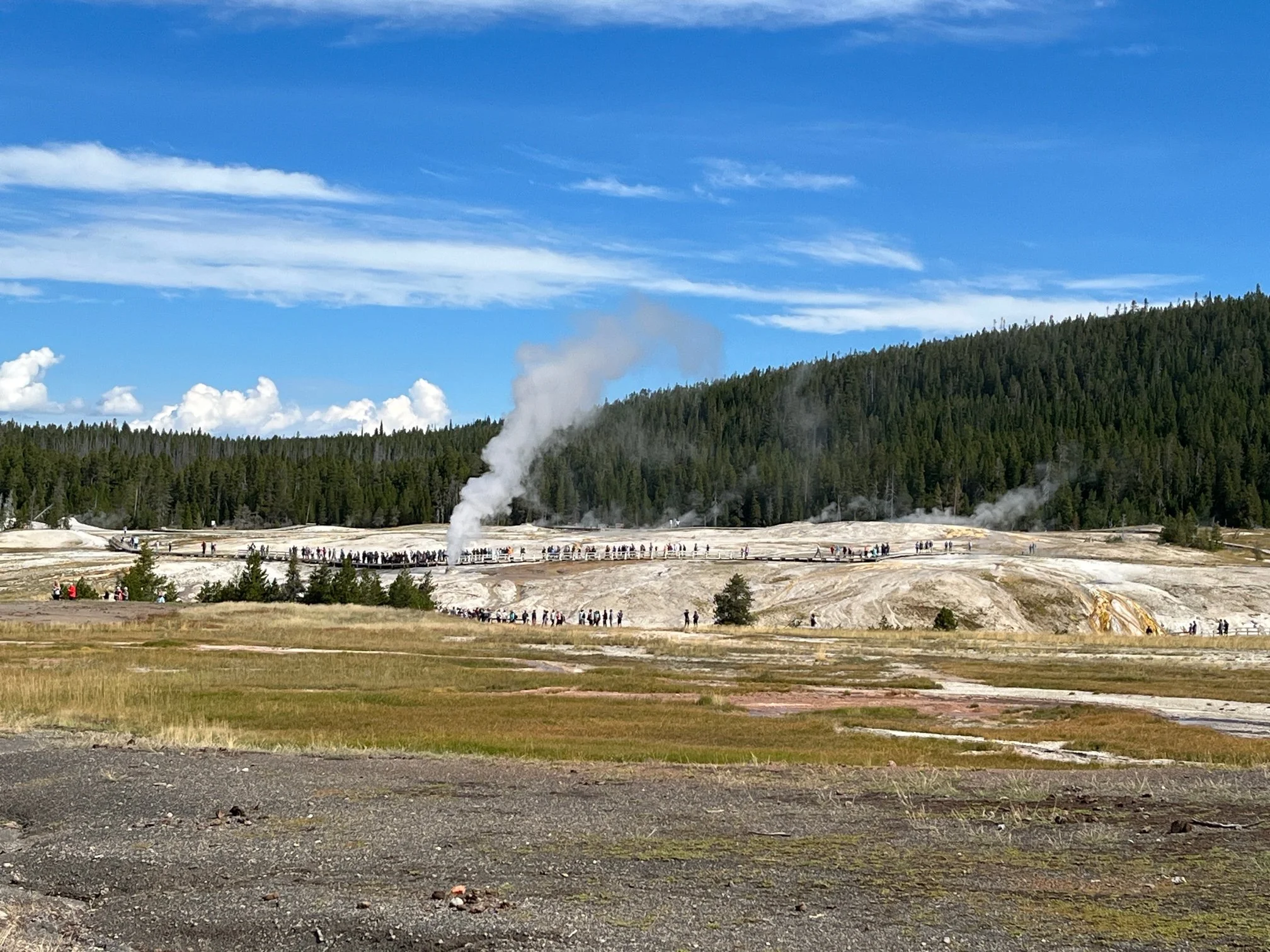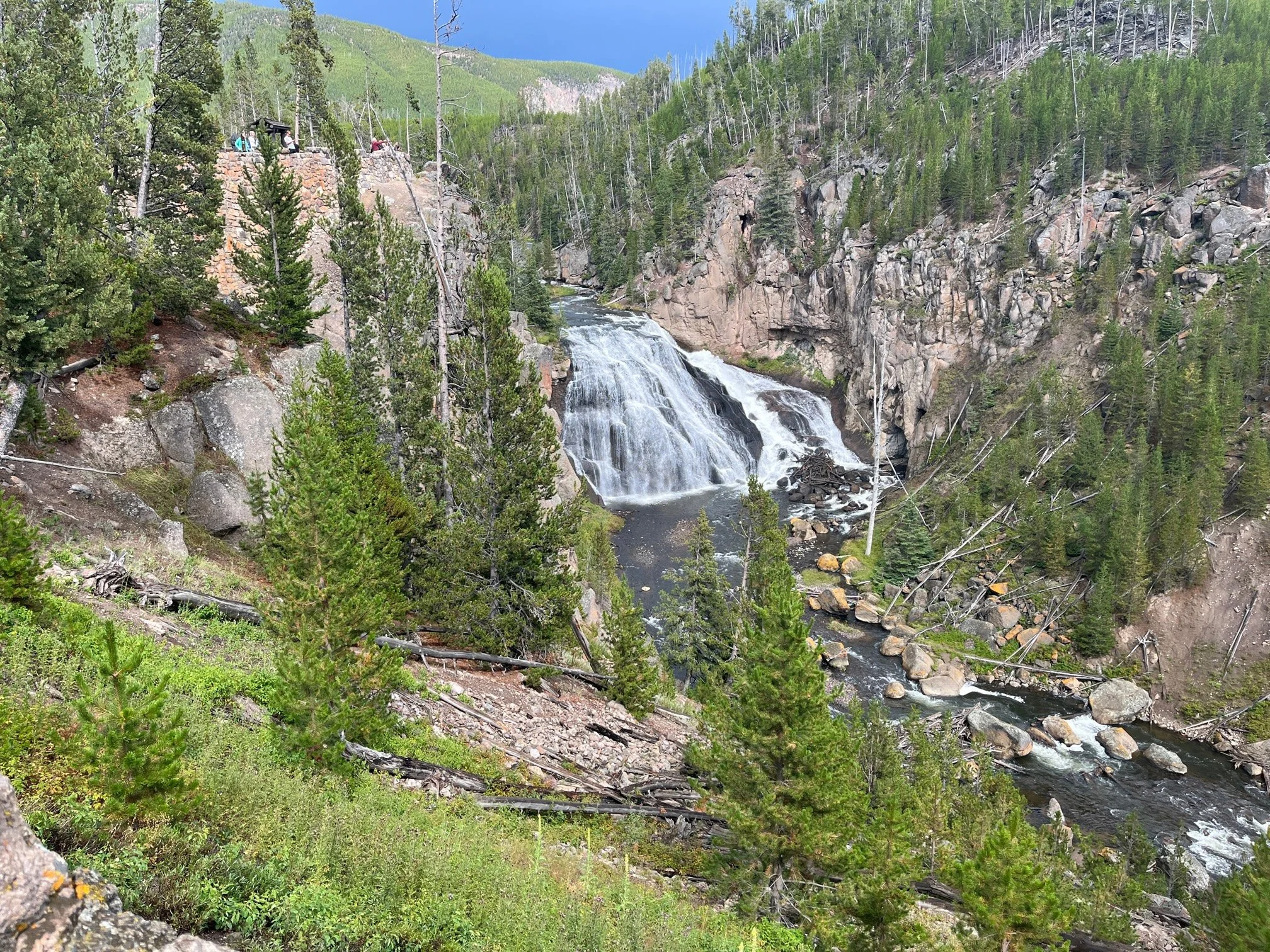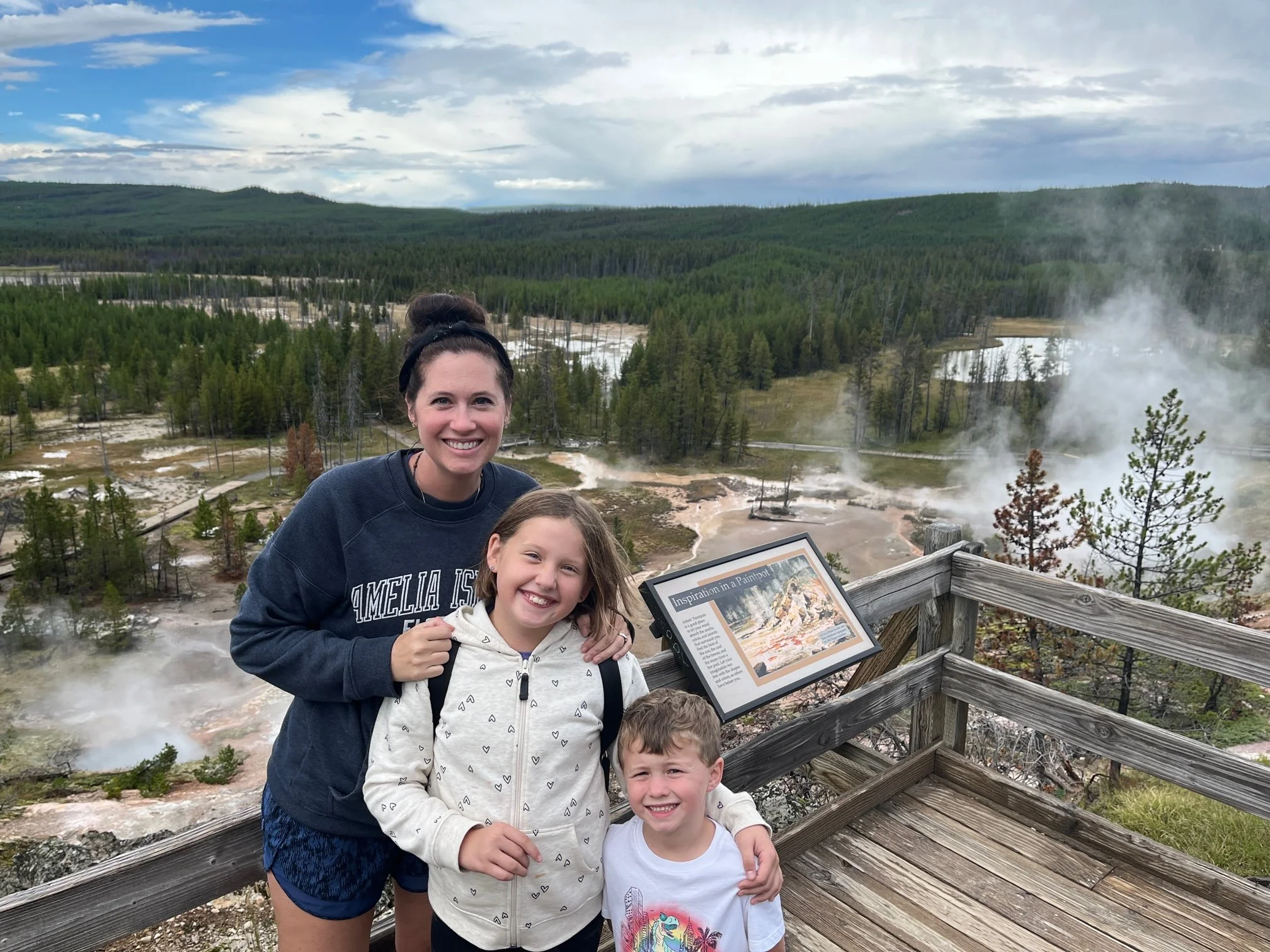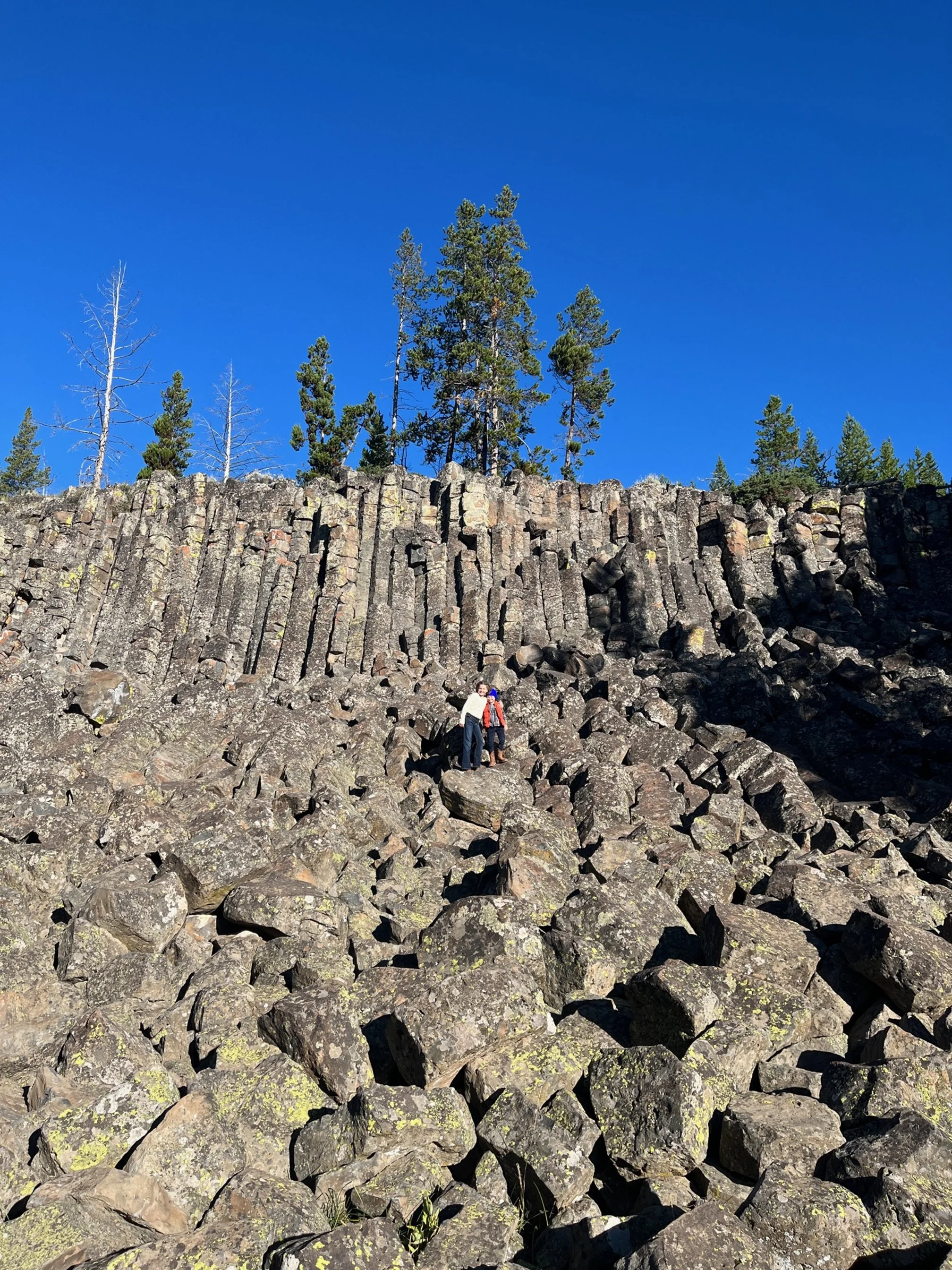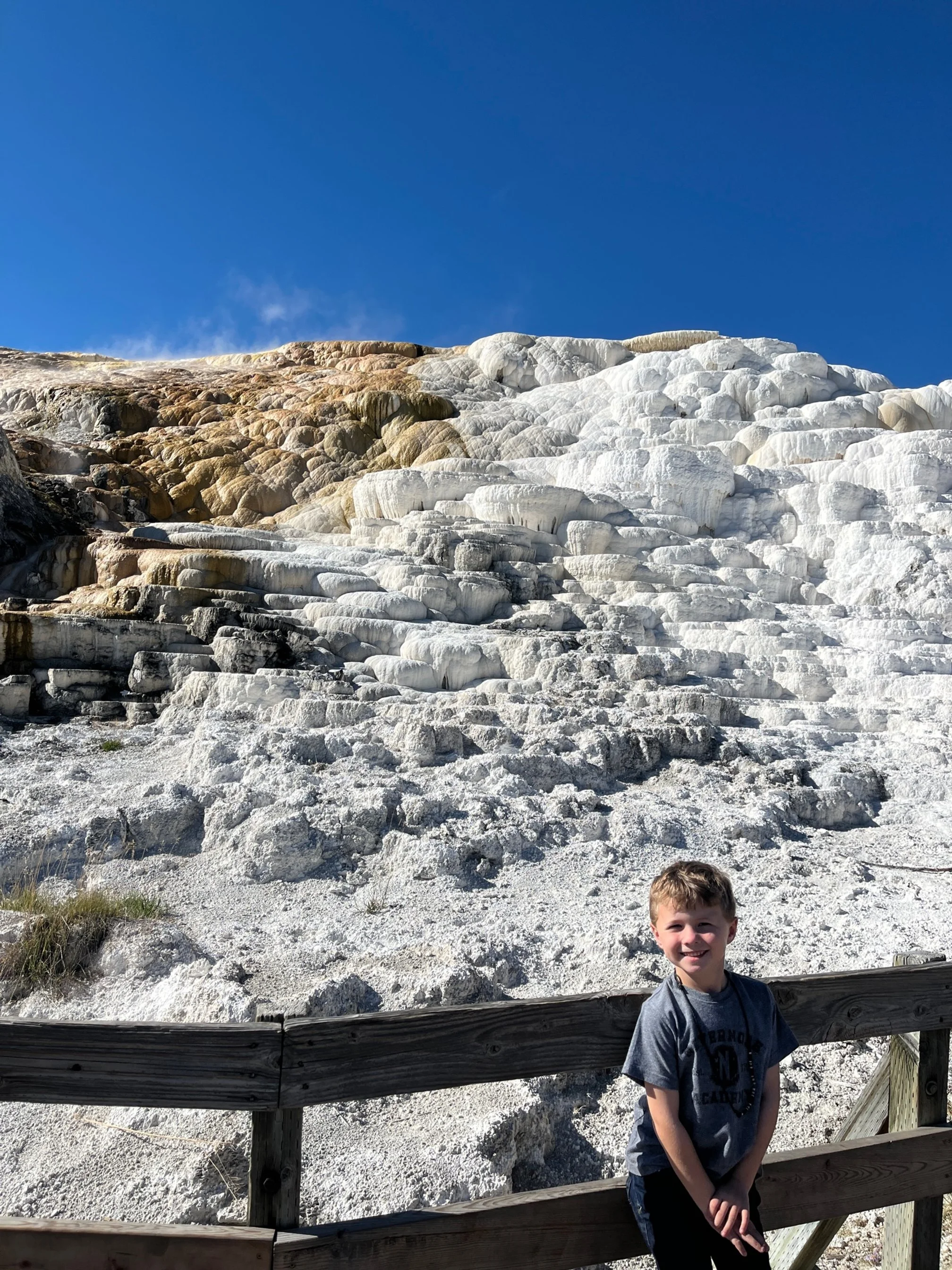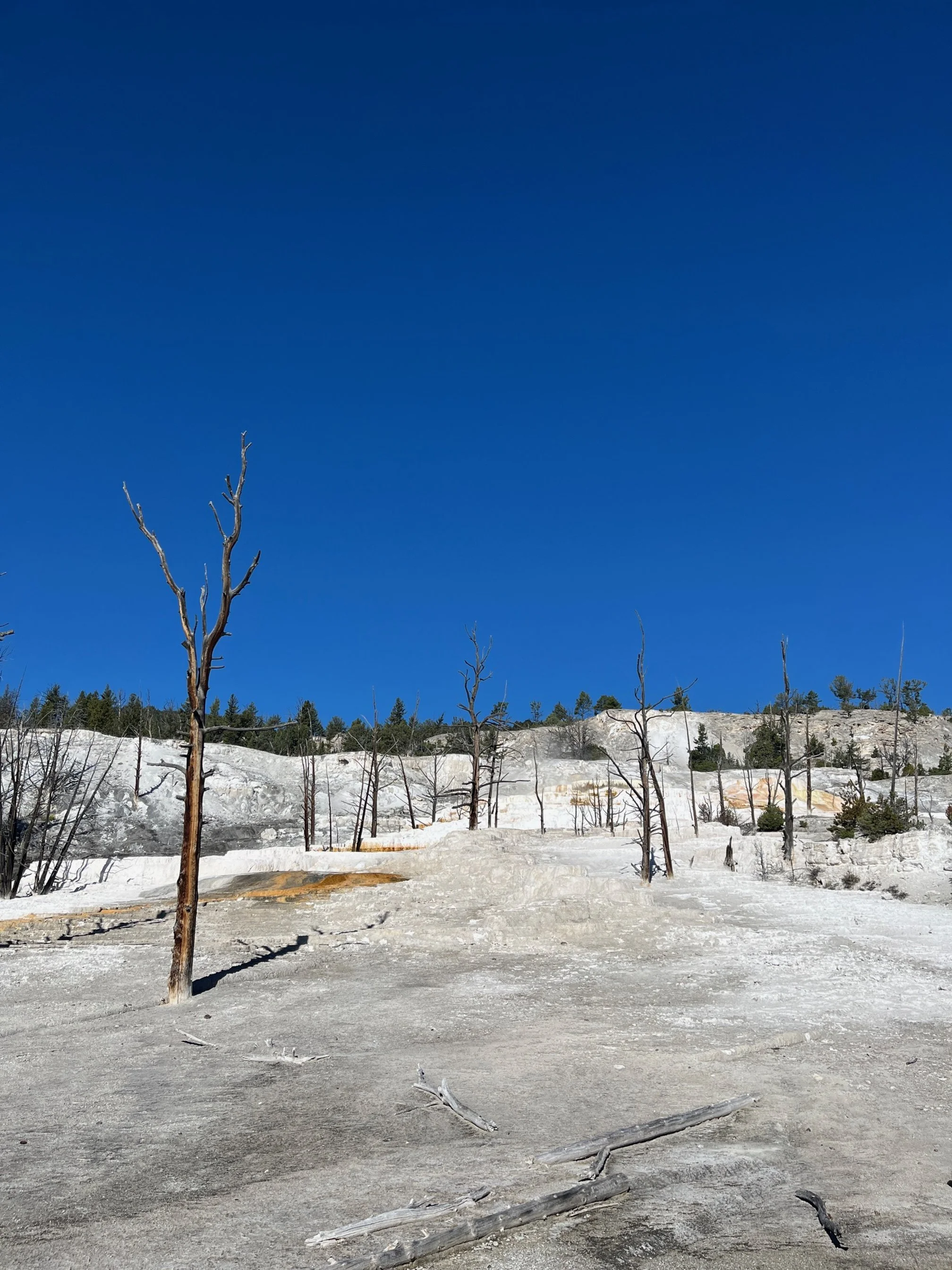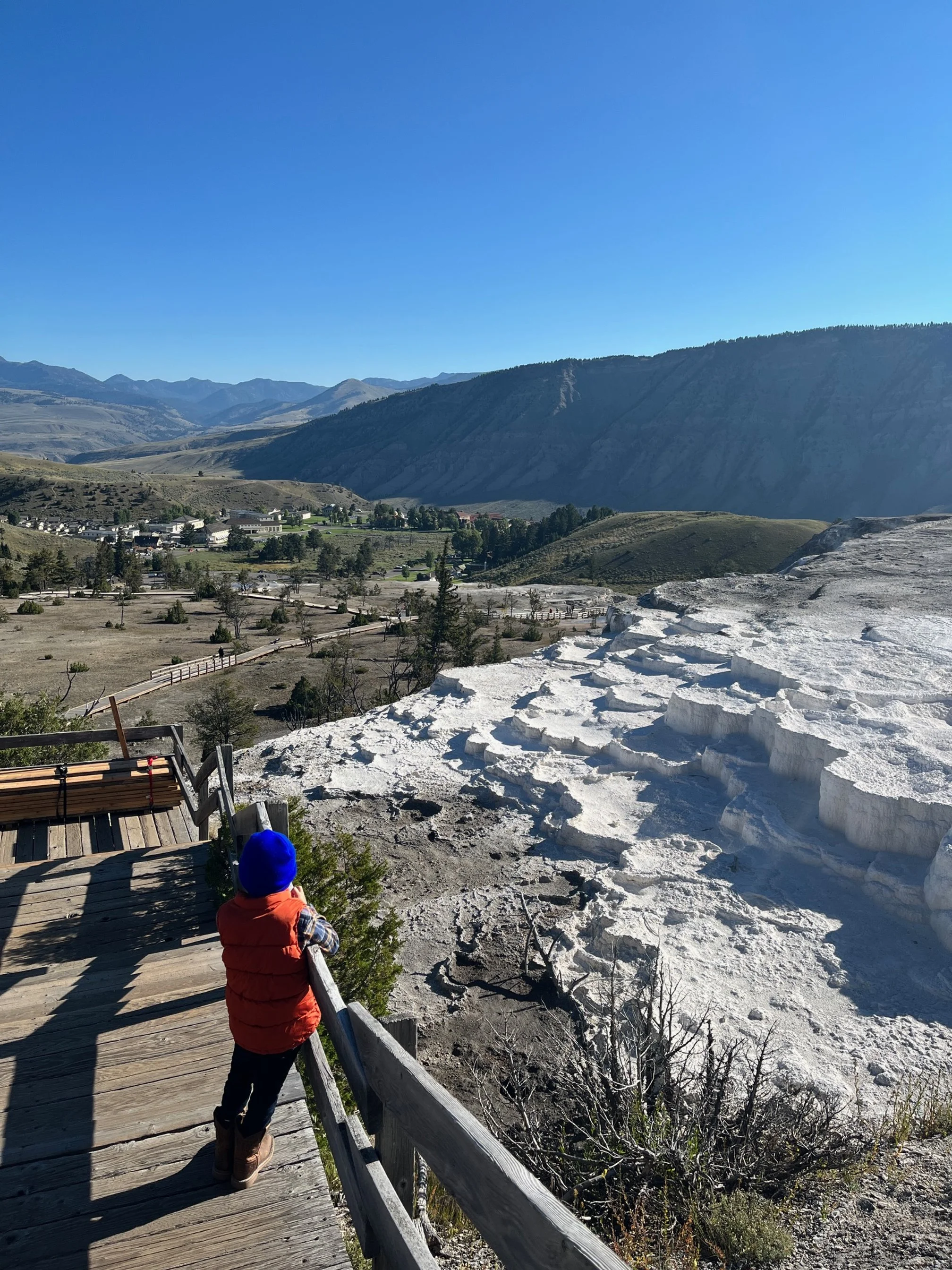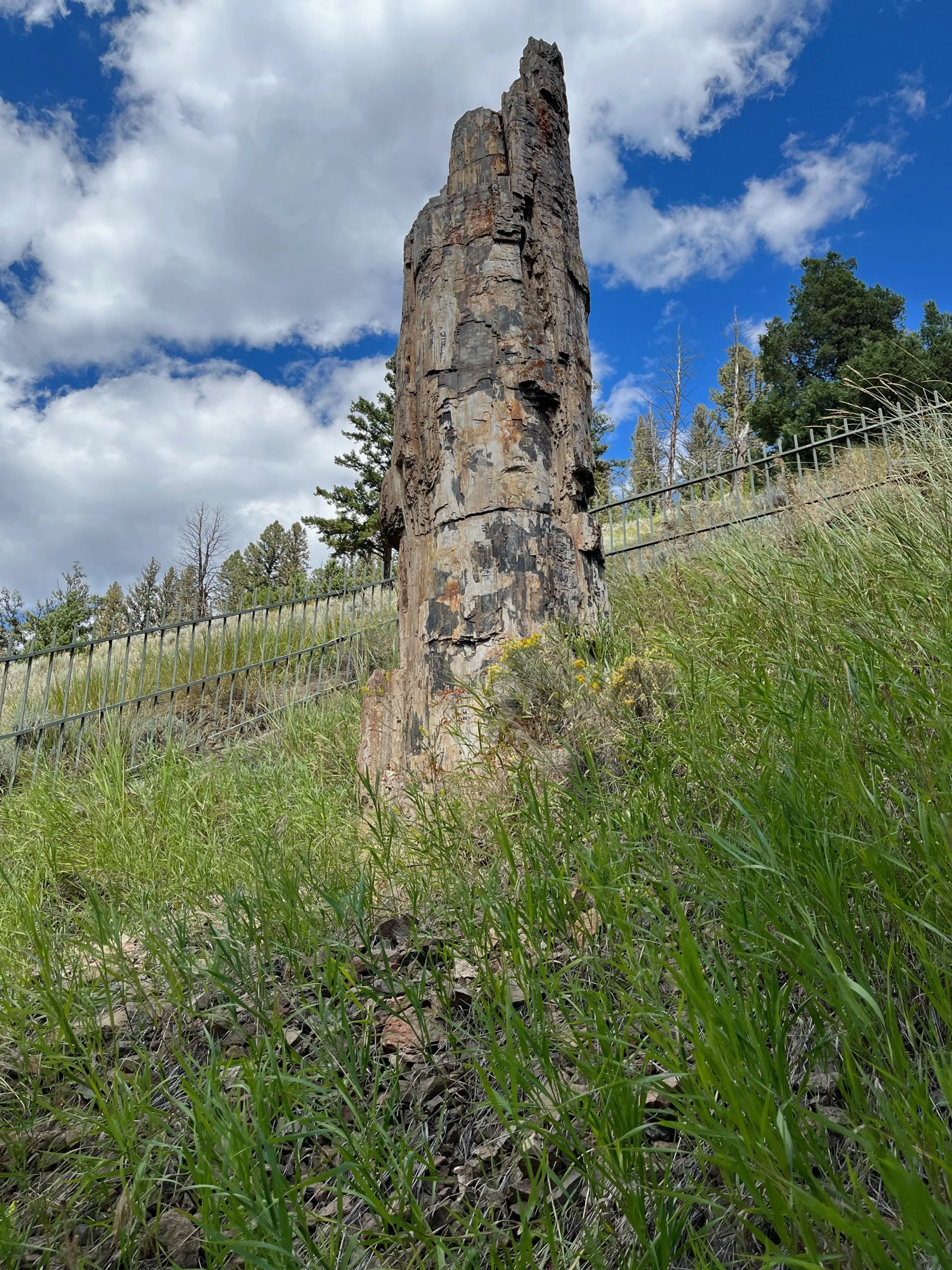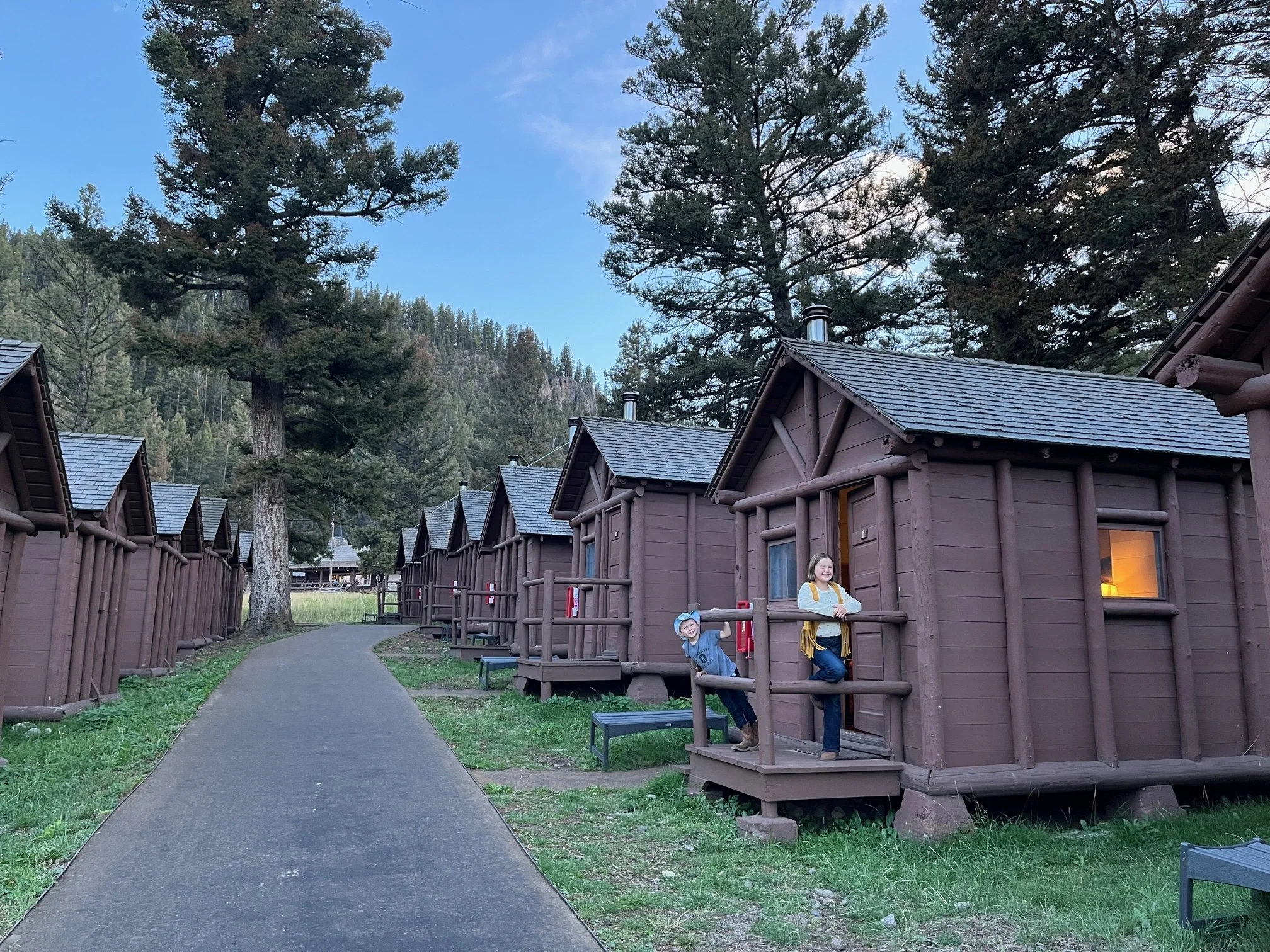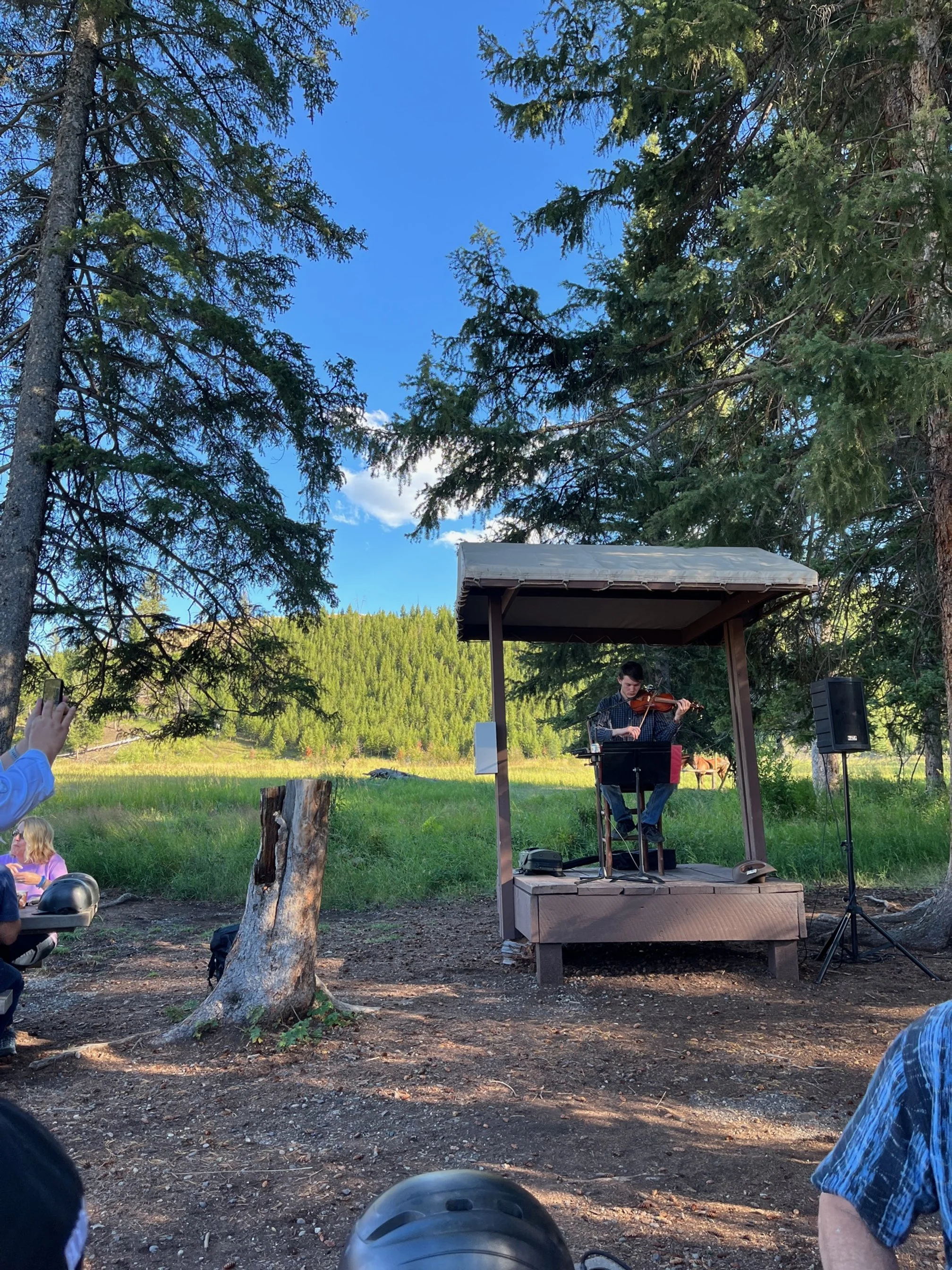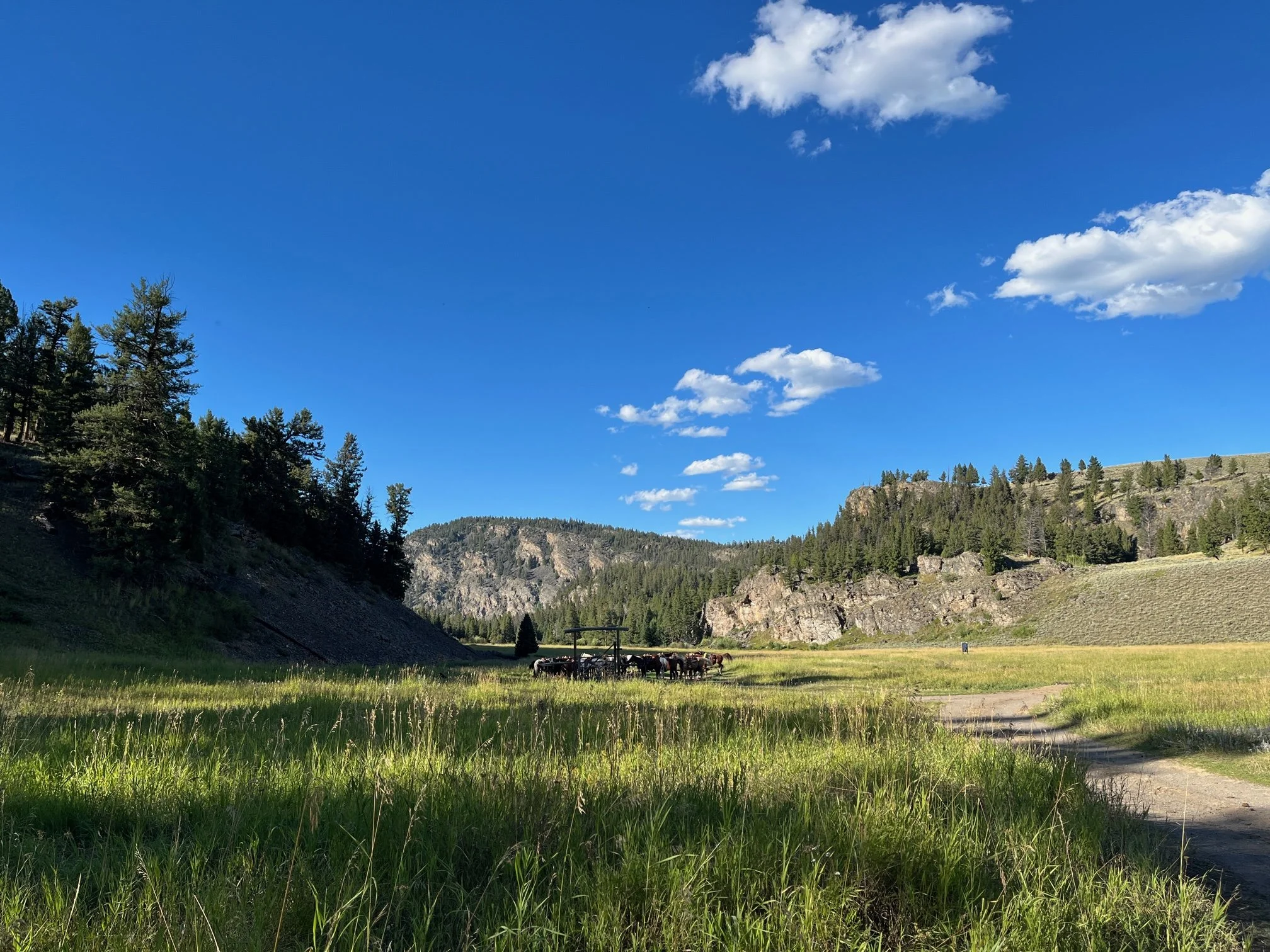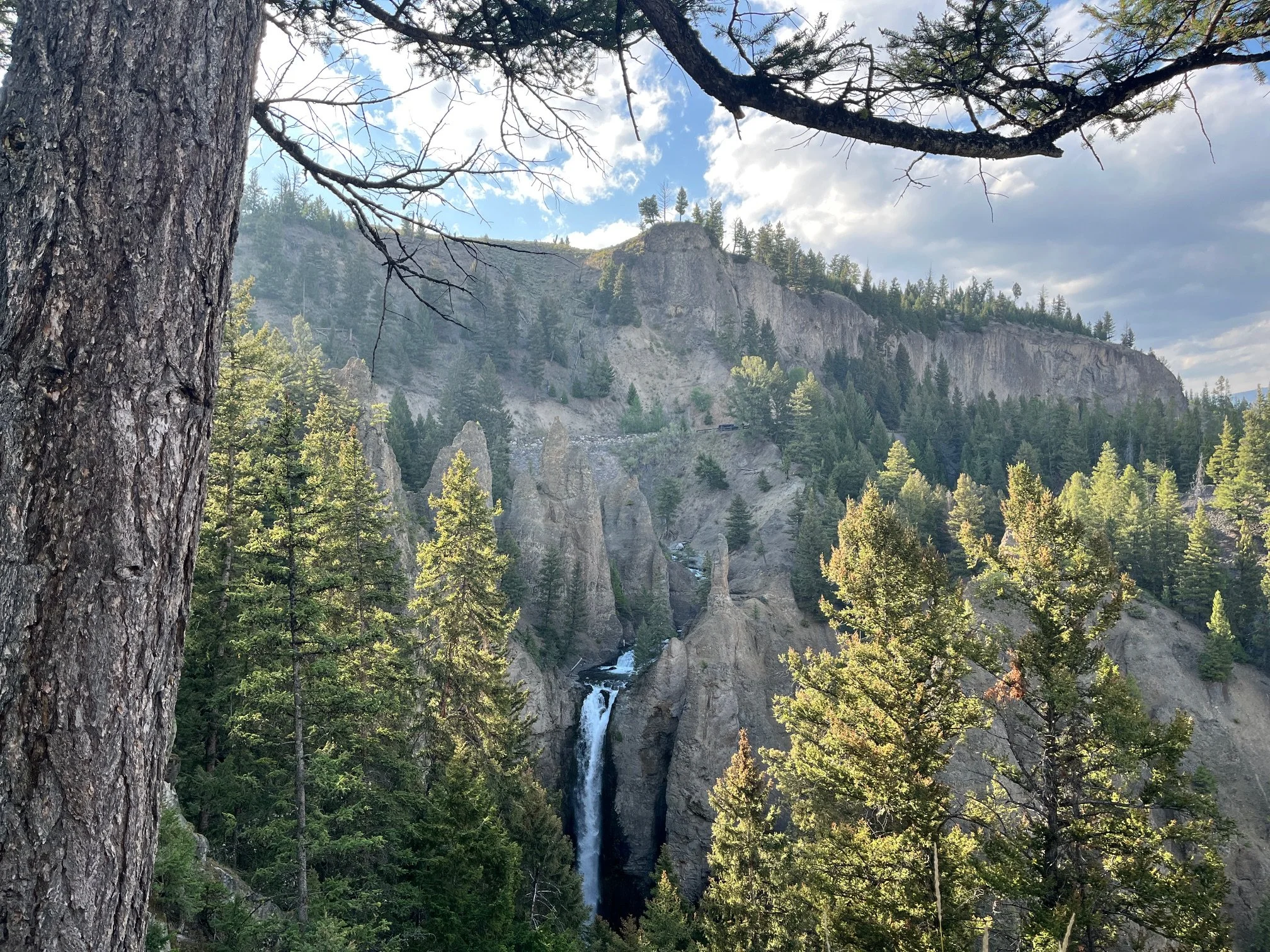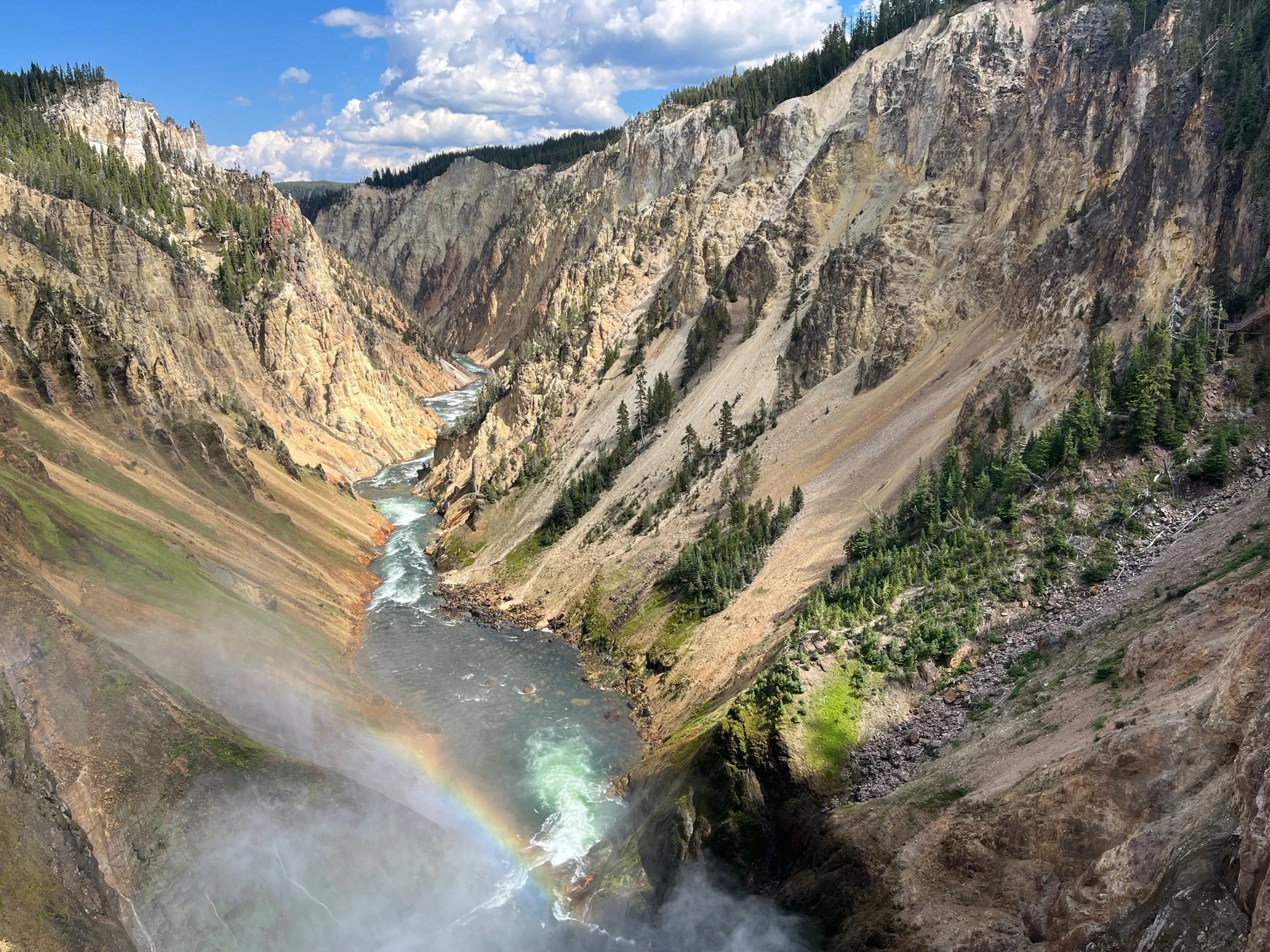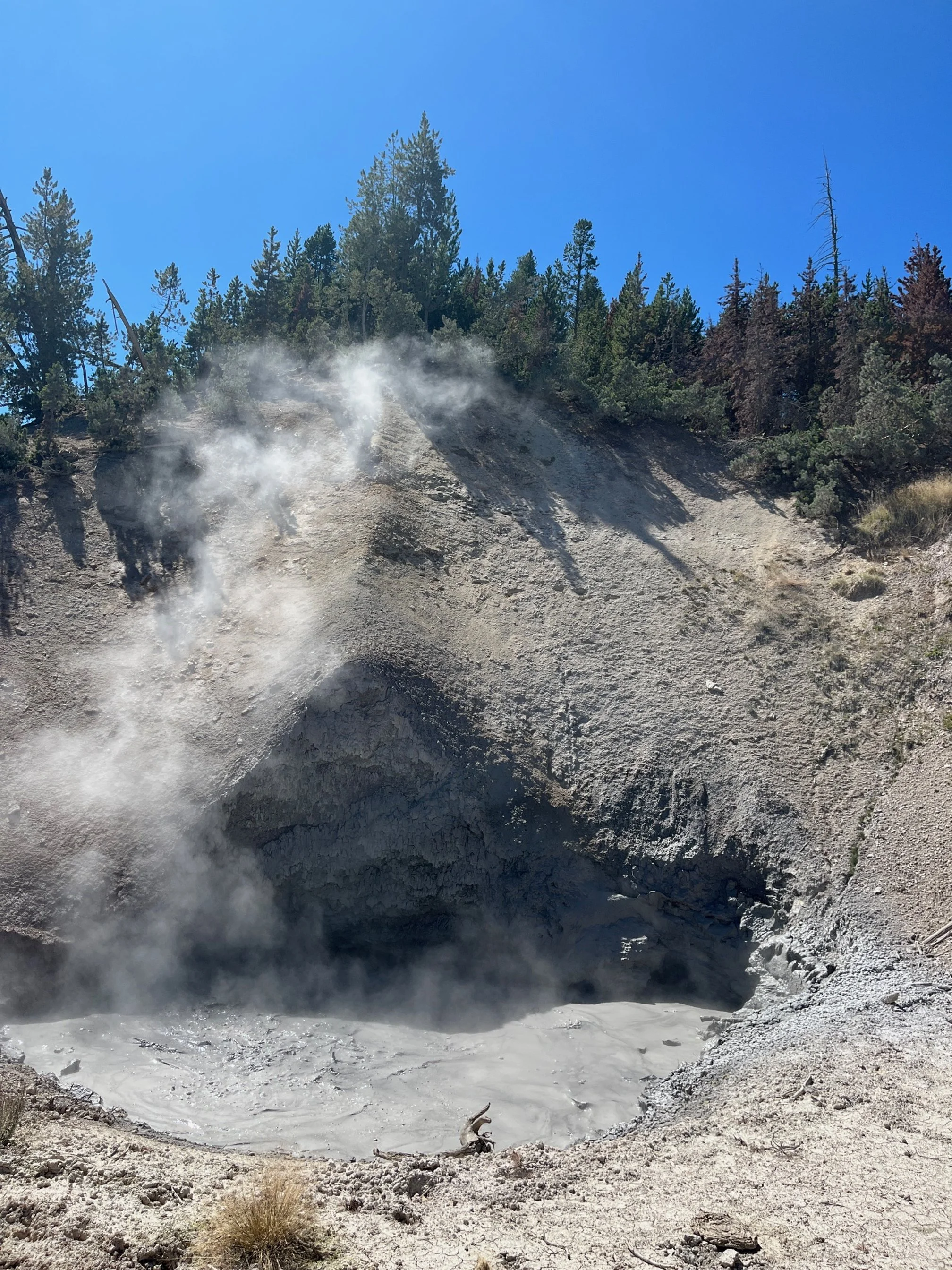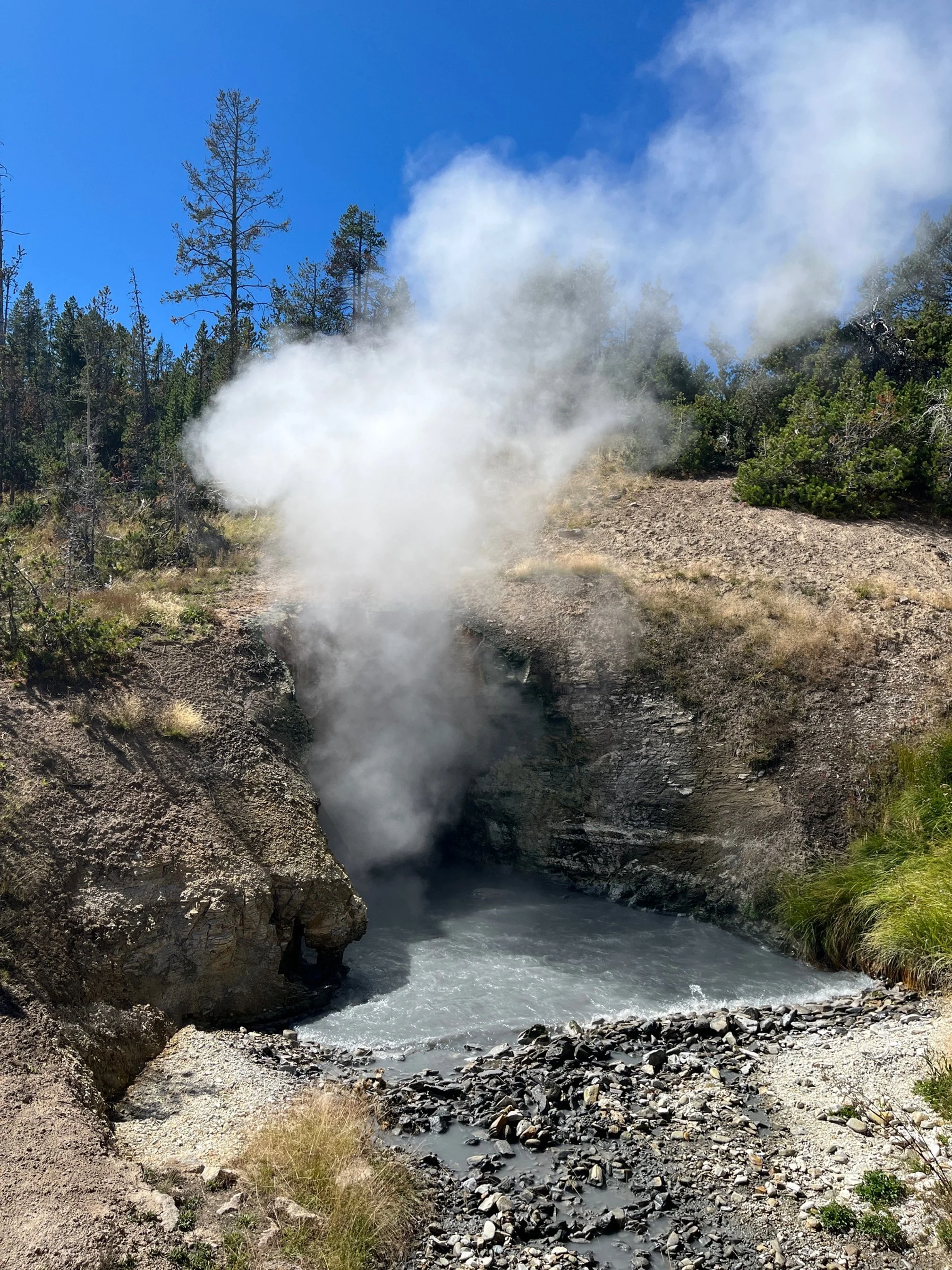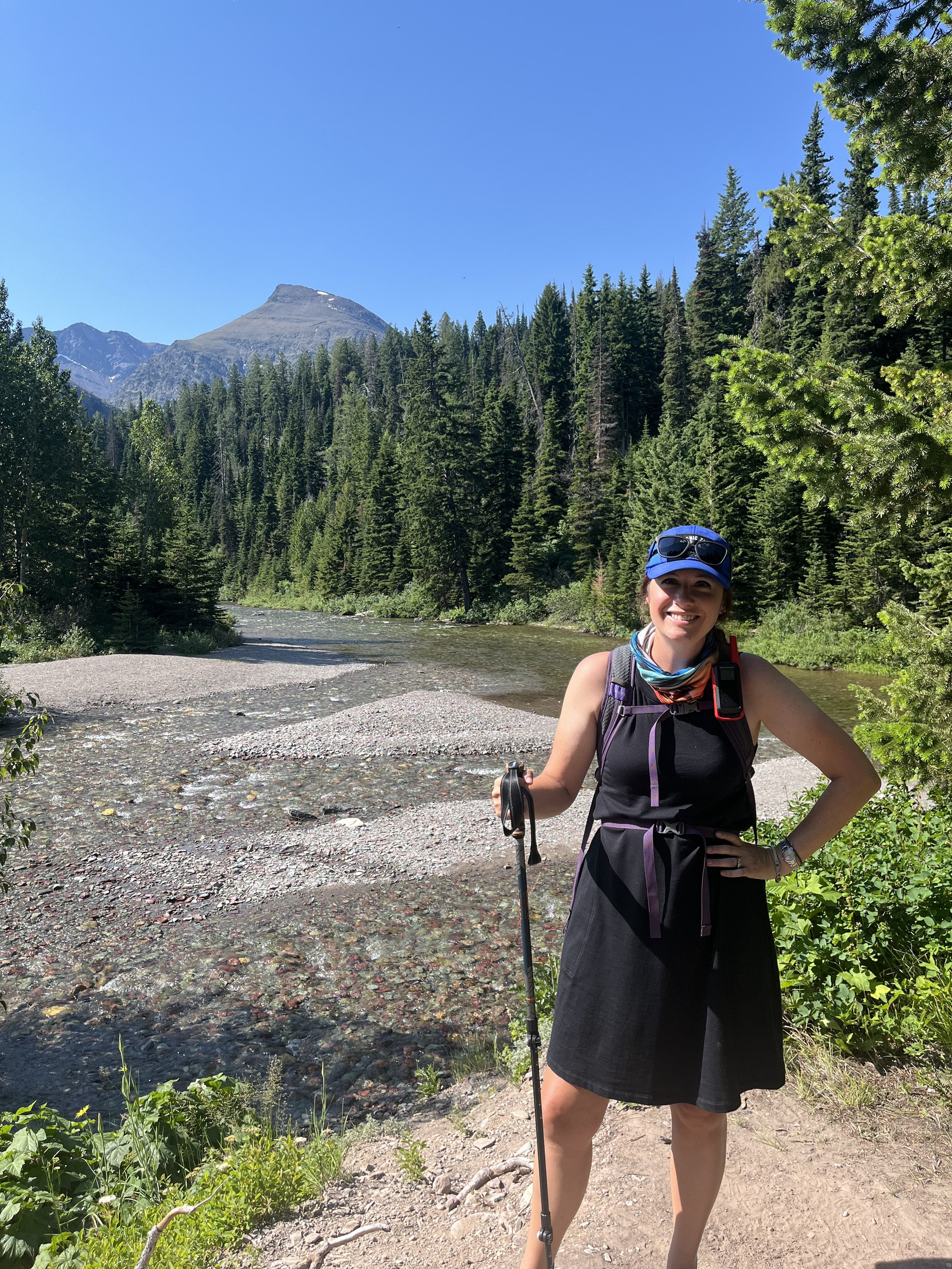15 Best Stops to Make on Yellowstone’s Grand Loop Road
Driving the Grand Loop Road in Yellowstone National Park is the best way to see everything that this beautiful place has to offer.
Spanning 140-miles, this road weaves through Hayden Valley, climbs to Dunraven Pass, and carries you past dozens of easily accessible geysers and trailheads.
All 5 of the park’s entrance roads connect to Grand Loop Road, giving you multiple options for exploring around Yellowstone.
In the guide below, you’ll find everything you need to plan your time on this scenic road, including the best stops, a full color map, and tips on how to make the most of your time driving around Yellowstone National Park.
Cars on the Grand Loop Road heading south towards Canyon Village
This post contains affiliates. If you purchase through the links below, I will receive a commission at no charge to you.
What is the Grand Loop Road?
A typical traffic jam on Yellowstone’s Grand Loop Road
The Grand Loop Road is a route that runs through the heart of Yellowstone National Park, linking the most visited areas together on a two-lane paved road.
Besides being a major sightseeing route for those exploring the first U.S. national park, the Grand Loop Road is where you’ll find all of the front country camping, hotels, and cabins in the park.
The route roughly looks like an oval, but there is a connecting road—Norris-Canyon Road—that turns the Grand Loop Road into 2 circles.
When the roads are all open in the summer, you can either do the entire Grand Loop Road, the upper loop, or the lower loop.
The entire Grand Loop Road is what I suggest for a complete Yellowstone experience, but if you’ve got limited time in the park, you might consider doing either the upper or lower loop.
The upper loop includes Tower Falls, Mammoth Hot Springs, and Dunraven Pass. It is accessible from both the northern, western, eastern, and northeastern entrances of the park.
The lower loop includes Old Faithful, Grand Prismatic Spring, Lake Yellowstone, and Hayden Valley. It is accessible from the western, eastern, and southern entrances of the park.
>> For more information on the 5 different entrances to Yellowstone and what to find at each, read my complete blog post! <<
Keep in mind that the roads in Yellowstone are often blocked by snow after the end of October, making this entire route impassable by car between October and April.
For more information on specific open and close dates of the sections of Grand Loop Road, please see this NPS site.
TIP: Purchase the inexpensive but fantastic GuideAlong audio tour for Yellowstone National Park to make your Grand Loop road trip even more engaging. Once the tour is downloaded to your phone, you don’t need wifi, which is great for those remote corners of the park. The tour starts and stops automatically as you approach points of interest, and you can relisten to any sections you’d like.
Best Stops on Grand Loop Road in Yellowstone
Get itineraries, hiking guides, lodging and dining suggestions and much more over at our complete Yellowstone National Parks planning page!
PIN ME!
You could easily spend several weeks slowly meandering around the Grand Loop Road, checking out every scenic overlook, geyser basin, boardwalk, and trail.
But, unfortunately, most of us have limited vacation time and need to stick with the highlights.
Below, I’ve compiled my 15 favorite things to do and see on the Grand Loop Road.
If you’re traveling with kids, know that all of these suggestions are kid-friendly. They’re also great for the casual hiker and traveler who wants the most memorable experiences in a short time frame.
To make it as easy as possible to follow, I’ve organized the stops starting at the one nearest the southern entrance to the park and worked clockwise around the park.
My map also has all of the same stops if you’d like a clearer visual on where each is in the park.
That being said, you can jump onto this loop drive at any of the entrances. I’ve noted what’s closest to each entrance in the descriptions below.
West Thumb Geyser Basin
If you’re making a stop at Grand Teton National Park before you head to Yellowstone, you’re perfectly placed to enter Yellowstone through the southern entrance.
From that entrance to the Grand Loop Road is 21 miles. You’ll enter the Grand Loop Road at our first stop, the West Thumb Geyser Basin.
This area has easily walkable wooden boardwalks, a large parking area, and vault toilets.
As you explore the boardwalks, you’ll see multiple hot springs in a variety of vibrant colors. You’ll also have incredible views of Lake Yellowstone, on the banks of which you’ll find the Fishing Cone geyser.
It’s an excellent introduction to the park’s many geysers and hot springs that’s usually far less busy than the popular Old Faithful.
Kepler Cascades
Kepler Cascades
After walking through the West Thumb boardwalk, get back in the car and head 15.3 miles northwest on Grand Loop Road. (You’ll be going away from the lake and following signs towards the Old Faithful area.)
To your left will be a pull off area, which is the parking lot for Kepler Cascades. There’s not much signage, so keep an eye out it when you hit 15 miles.
From the parking lot, it is an easy walk out onto the observation platform where you can take in the full scope of Kepler Cascades. This is the first of 3 suggested waterfall stops on the Grand Loop, and it has the shortest walk (so take advantage of that if you’re short on time).
The waterfall runs down multiple cascades, covering 150 feet among all of its drops.
Old Faithful
The famous Old Faithful is next on our route, so you’ll get to compare the offerings here to what you saw previously at West Thumb.
I will note that there are an incredible number of geysers and hot springs in this park, and unless you’re obsessed with hydrothermal features, it’s easy to get burnt out on them. Because of this fact, I’ve only suggested stopping at hydrothermal features that are particularly unique and/or easy to access.
That being said, it would be hard to go to Yellowstone and NOT stop to see Old Faithful.
True to it’s name, this geyser erupts every hour to hour and a half (roughly—it doesn’t have a watch, after all).
There’s an excellent eruption estimator on the official NPS app, which will give you an approximate time +/- 10 minutes as to the next Old Faithful show.
If you miss one, you can get a bite to eat or walk around the shops in this large complex before taking up your spot on the boardwalk circling the geyser.
NOTE: If you really want to indulge in some geysers and hot springs, you will find about a dozen that are easily accessible via the network of trails at the Old Faithful area. I haven’t included any of those on this guide, but they are a great add-on if you have some extra time in this part of the park.
Grand Prismatic Spring
21 miles north of Old Faithful on the Grand Loop Road is Grand Prismatic Spring.
If you only have time for ONE hot spring on this trip, make it this one.
This massive spring is so beautifully colored that it looks to be fake, but it’s really the work of the different minerals in the water. You’ll be able to see reds, oranges, yellows, blues, and greens in the spring.
The parking at the main boardwalk area can be rough, but be patient and something will open up.
For a better perspective of the spring, I highly recommend the Grand Prismatic Spring Overlook Trail, which shares a parking area with one end of the Fairy Falls Trail. You’ll find that parking area just before the main Grand Prismatic boardwalk parking area on the Grand Loop Trail.
For more information, check out my hiking guide to the Grand Prismatic Spring Overlook Trail here.
Gibbon Falls
Gibbon Falls as seen from the second overlook
Continue north on Grand Loop Road, making sure that you keep on the road at the intersection with West Entrance Road. If you need a meal or an overnight stay, you’re only 14 miles to the west entrance of the park and to the town of West Yellowstone, Montana, at that intersection.
5 miles from the intersection is a large waterfall with a paved parking area. You’ll be able to get glimpses of the falls from the road, but it’s best seen from one of the 2 overlook areas that require walking.
NOTE: There is also a Little Gibbon Falls on the Norris-Canyon Road, so be careful when you enter the information into your GPS so that you end up at the right one.
Artists Paint Pots Trail
Keep on Grand Loop Road after leaving Gibbon Falls as you follow signs to the Norris Geyser Basin.
When you get to Norris Geyser Basin, continue north. If you really love geysers and hot springs, you can make a stop here, but the ones at Old Faithful and West Thumb are more interesting in my opinion.
Another potential side trip before the Artists Paint Pot Trail is Roaring Mountain, but it’s not a must-do in my opinion. Roaring Mountain has multiple steam vents on the side of it, which make a very distinctive hissing sound as the steam is released from the rock.
You can’t get very close to the mountain—for good reason—and the steam vents aren’t super loud, so this experience is one of those that feels like it should be more interesting than it actually is.
Whether or not you stop, continue past Roaring Mountain to get to the parking area for Artists Paint Pots Trail.
This kid-friendly trail, one of the best easy hikes in Yellowstone National Park, is filled with hydrothermal features.
And not just any hydrothermal features. There’s a deep red geyser, thanks to the high iron content along one part of the trail. Another is a bright, milky blue. There are large areas of plopping mud pots, and an incredible long range view of Mount Holmes from the top of the wooden stairs.
Click here for a complete guide to the Artists Paint Pots trail.
Sheepeater Cliffs
The Camping Kiddos at the Sheepeater Cliffs
Your next stop on the Grand Loop Road is the Sheepeater Cliffs, which is home to some incredible hexagonal basalt lava rocks.
There’s a small dirt parking area at the base of the cliffs.
From there, you can explore on the rocks, but use caution.
The individual rocks are piled loosely on one another, and the rock columns still part of the cliff could come down at any time.
You’ll find a couple of picnic tables here, and a trail down by the river.
The trail is actually one of the ski trails in this part of the park, but you can hike down it in the warmer months.
It runs right along the river for 2.7 miles before intersecting with the Bunsen Peak service road.
Mammoth Hot Springs
Sitting at the edge of the park near the north entrance, Mammoth Hot Springs is a stop with many different ways to explore it.
For those who are on a time crunch and just need the highlights, you can do the Upper Terrace Loop Drive, passing multiple hot springs in the process.
This upper terrace area is also where you’ll see one of the most interesting sites in the park: the true effects of the acidic spring water on what was once a forest. The dead trees on the stark white rock look like it would be home in the Namib Desert and not a corner of Wyoming!
The upper and lower terraces are joined by a series of wooden boardwalks. These do have stairs, so you won’t be able to bring the stroller along for this one.
The lower terraces include the Liberty Cap, a dormant hot spring. Liberty Cap is so named because it shares a shape with a mushroom by the same name.
Another must-do on the lower terraces is Devil’s Thumb, which has hot spring water cascading over white, yellow, and orange tiers.
The petrified tree on the Grand Loop Road
Petrified Tree
On the Grand Loop Road between Mammoth and Tower-Roosevelt, there’s a side road to see the Petrified Tree.
If you’ve been to Petrified Forest National Park, this tree probably won’t be that impressive, other than the fact that it is still standing vertically.
But if you’re interested in fossils or natural history, it’s worth the side trip.
(For what it’s worth, we’d been to Petrified Forest just a few months before seeing Yellowstone’s petrified tree, and I still though it was worth the slight detour.)
There’s not a lot of parking at this stop, but people do move quickly in and out since the tree is the only thing to see here.
You’ll need to walk a couple of hundred feet on a sidewalk from the parking area to the tree, but it is fairly easy other than a slight incline.
Roosevelt Corrals
The next stop is in Tower-Roosevelt, which essentially a crossroads between the Grand Loop Road and the Northeast Entrance Road.
But this tucked away corner of the park has one of our favorite lodging options and one of our favorite dining/excursion options.
The cabins at Roosevelt Lodge are adorable and a true throwback to the park’s frontier past. Many of these cabins were moved to their current location from around the park, and they have a rustic charm that isn’t found in any of the other Yellowstone lodging options.
Read my full review of the Roosevelt cabins here.
Next door to the Roosevelt Lodge is the Roosevelt Corrals, where you’ll find the starting point to the Old West Dinner Cookout.
Here, you can channel your inner cowboy or cowgirl and ride the range to a hardy outdoor dinner. There’s live fiddle music and a sing-a-long, as well as steak, salad, fresh fruit, cornbread, and much more.
You’ll get there from the corrals either on horseback or by stagecoach.
Read my complete review of the Old West Dinner Cookout.
NOTE: Another easy side trip from Tower-Roosevelt is to take Northeast Entrance Road to Silver Gate or Cooke City, Montana, so you can drive through the beautiful Lamar Valley. You’ll often be able to spot large herds of bison through here! Even further along this road outside of the park, you can hop on the unforgettable Beartooth Highway.
Tower Falls
Tower Falls as seen from the upper overlook
As you continue south on the eastern side of Grand Loop Road, you’ll come to Tower Falls less than 2.5 miles from the intersection at Tower-Roosevelt.
Tower Falls is the 2nd of the 3 waterfalls recommended on this scenic drive, and each is very different.
Unlike the Kepler Cascades (above), Tower Falls is a single drop of 135 feet. Tower Falls is also much narrower as it flows between 2 distinctive jutting rocks—or the towers in the name.
The parking lot here is very large, and you should be able to find a spot even at the busiest of the times. There’s also a gift shop and convenience store with grocery basics and ice cream.
To get to the falls overlook point, it’s a wide, paved path that’s easily accessible from the parking area. There is another dirt trail that leads down to the river and lower overlook, but it is steeper than it looks.
Dunraven Pass
After leaving Tower Falls, you’ll climb into the mountains as you pass Mt. Washburn and Dunraven Peak.
It’s one of the prettiest areas of the park, especially as you ascend towards Mt. Washburn. Keep a lookout as pronghorn and bighorn sheep are seen along the road.
If you’re planning to hike the 7 mile out-and-back Mt. Washburn Trail, you’ll find the trailhead here.
If you’d rather take in the views without a hike, head to the Washburn Hot Springs Overlook on the Canyon Rim side of the pass.
Grand Canyon of the Yellowstone
The Grand Canyon of the Yellowstone from the Brink of the Lower Falls viewpoint
One of the high points of this scenic drive is the Grand Canyon of the Yellowstone, which often gets forgotten among the more well known sites of Grand Prismatic Spring and Old Faithful.
Yet, the Grand Canyon of the Yellowstone is well worth your time—and if you’ve seen the Grand Canyon in Arizona, you’ll still be impressed.
The Yellowstone River cascades through the Grand Canyon of the Yellowstone, and there are multiple viewpoints on both sides of the river to suit all levels of fitness and time outlays.
If you have an hour or so, the South Rim Trail from the Upper Falls Viewpoint to Artist Point is beautiful. There are some areas with steep drop-offs, so be aware of that if you’re afraid of heights.
The Brink of the Lower Falls Trail on the northern side provides the best view of all. But be warned: going down to the viewpoint is the easy part. The way back to your car is all uphill!
If you want a very easy viewpoint, opt for Artist Point on the South Rim. It’s a nearly flat, paved walk from the parking area to the best overlook.
Hayden Valley
It wouldn’t be a trip to Yellowstone without spotting some wildlife!
While you can see wildlife anywhere in the park, you have the best chances of seeing a wide variety of species and/or larger bison herds in Hayden Valley and Lamar Valley (to the north, near Tower-Roosevelt).
The drive through Hayden Valley is beautiful, and there are many areas to pull over if you see one of the many animals who call this area home.
Look for elk, deer, swans, bison, and even bears.
Mud Volcano
And last, but certainly not least is the Mud Volcano area.
This part of the park has 2 loop trails, each with its own set of hot springs, mud pots, and geysers.
The mud volcano for which the area is named is actually a massive mud pot that is slowly eating away the cliff behind it.
On the lower boardwalk just down from Mud Volcano, is my favorite hydrothermal feature in the entire park: the Dragon’s Mouth spring.
Here, you’ll stand on a wooden platform to watch steam rolling out of the mouth of a cave, which is accompanied by little waves and a deep rumbling sound. It absolutely looks and sounds like a dragon is hiding in the cave just out of sight!
